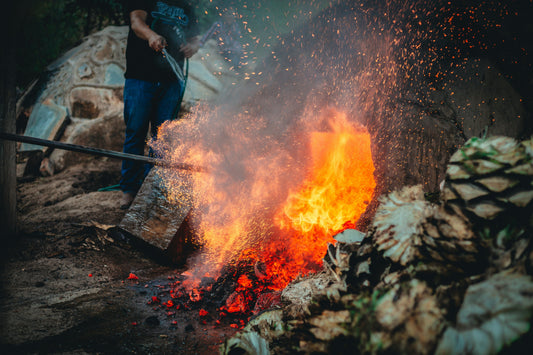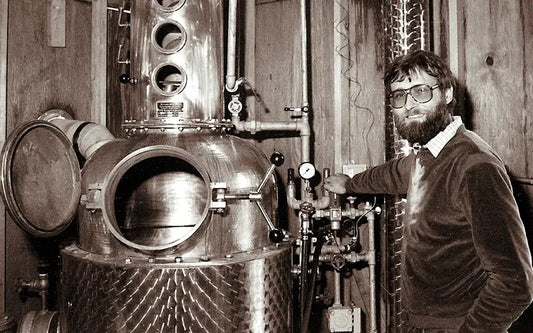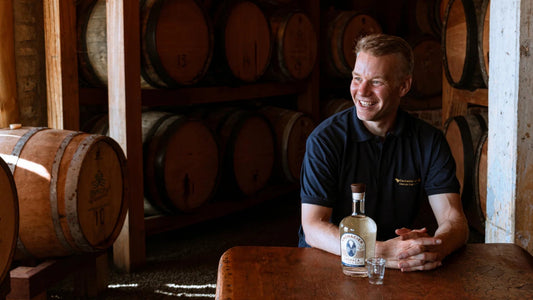Intro: California in a Glass
Walk into our shop asking for “something with personality,” and we’ll probably reach for St. George. The Alameda distillery has a knack for capturing place—redwood and coastal sage in gin, fresh peppers in vodka, pear orchards in liqueur, café vibes in coffee liqueur, and a full-tilt, herbaceous absinthe that finally made the spirit fun again. Each bottle reads like a postcard from California, mailed straight to your bar.
“St. George doesn’t make ‘base spirits.’ They make conversation starters.”
A (very) short story
Founded in the early 1980s and still independent, St. George built its reputation by experimenting without losing respect for tradition. Their lineup today proves the point: distinctive gins, a cult-favorite chile vodka, liqueurs with real depth, and an absinthe that helped rewrite the category in the U.S. after the ban was lifted in 2007.
How they get that flavor (and why it matters)
- Ingredient-first choices. Local botanicals and fresh produce drive the profile, from forest botanicals in Terroir Gin to chilies and citrus in Green Chile Vodka.
- Copper and craft. Traditional methods where they count, innovation where it helps—result: clarity of flavor without gimmicks.
- Category fluency. They don’t just “make a gin” or “make a liqueur”—they build a point of view for each category and let ingredients do the talking.
Why we carry St. George
Because these bottles teach as much as they delight. You can pour two gins from the same producer and taste completely different landscapes. You can make a Margarita with Green Chile Vodka for a garden-fresh kick. You can add a half-ounce of Spiced Pear and turn an Old Fashioned into sweater weather. St. George spirits are tools you’ll actually reach for, again and again.

What’s on our shelf (and how each drinks)
St. George Terroir Gin
Woodsy, wild, and unmistakably West Coast. Built on a backbone of forest botanicals (think Douglas fir and California bay laurel) with bright coastal accents, Terroir tastes like a hike that ends at a perfect barstool. Incredible in a Martini with a lemon twist, or in a simple G&T where the tonic gets out of the way.
St. George Botanivore Gin
“Botanivore” = “botanical eater,” and the name fits: an elegant, layered gin with garden-fresh herbs, citrus lift, and subtle florals. If Terroir is a redwood grove, Botanivore is your sunny kitchen window full of herbs. Versatile across a Southside, Bee’s Knees, or classic Gin & Tonic.
St. George Green Chile Vodka
Fresh, juicy, and alive—this isn’t flavored vodka; it’s an ode to peppers. Expect a vegetal snap, cilantro complexity, a hint of lime peel, and just a polite touch of heat on the finish. Makes a next-level Bloody Mary, bright Mule, or Ranch Water riff.
St. George Spiced Pear Liqueur
Ripe Bartlett pear in stereo—perfumed on the nose, rich on the palate—framed by warm baking spice. Use a splash in sparkling wine, add it to bourbon for a fall-leaning Old Fashioned, or drizzle a touch over vanilla ice cream.
St. George NOLA Coffee Liqueur
A love letter to New Orleans café culture: dark-roast coffee, chicory, vanilla, and a touch of sweetness that reads “coffee first, liqueur second.” Beautiful neat after dinner, magic in White Russians or Espresso Martinis that actually taste like coffee.
St. George Absinthe Verte
Real-deal American absinthe—brandy base, wormwood, fennel, star anise—released after the U.S. ban was lifted. It’s herbaceous, complex, and luxuriously oily even when louched, with mint/basil/lemongrass notes weaving through the anise. Build a classic Absinthe Frappé or rinse a glass for Sazeracs that actually sing.
Quick FAQs
Is Terroir really that “piney”?
Terroir leans woodsy thanks to its forest botanicals (including Douglas fir and bay laurel). Pine lovers cheer; citrus fans often prefer Botanivore for balance. Try both side-by-side—it’s a fun compare.
What peppers are in Green Chile Vodka?
St. George highlights fresh California-grown peppers, layering sweet and hot for flavor first, then a light, warming finish. Think fresh chile garden—not pepper extract.
How sweet is Spiced Pear?
It’s rich and pear-true, but built for cocktails—not syrupy. A half ounce can transform whiskey classics without turning them sweet.
What makes NOLA Coffee Liqueur different?
It tastes like a great cup of coffee—thanks to real coffee, chicory, and vanilla—so it reads sophisticated, not sticky. Fabulous neat or in dessert-adjacent cocktails.
Is their absinthe really “the first” back in the U.S.?
St. George Absinthe Verte is widely credited as the first legal American absinthe released after the U.S. ban was lifted in 2007—and it remains a benchmark.
One easy cocktail: Pear & Pepper Spritz
A bright, low-effort way to show off St. George’s range.
You’ll need
- 1 oz St. George Green Chile Vodka
- ½ oz St. George Spiced Pear Liqueur
- ½ oz fresh lemon juice
- 3 oz chilled dry sparkling wine (or soda for low/no-ABV)
- Lemon peel + thin pear slice (optional)
Build it
- Shake vodka, pear liqueur, and lemon with ice.
- Strain into a chilled wine glass with fresh ice.
- Top with sparkling wine. Express lemon peel; add a thin pear slice if you’ve got it.
Why it works
Green Chile’s freshness lifts the pear’s richness; bubbles keep everything light. It drinks like a party trick without the fuss.
Final thoughts
St. George makes bottles you’ll actually use. Whether you want redwood-grove gin (Terroir), garden-bright gin (Botanivore), a pepper patch in your Bloody, true-pear depth, coffee that drinks like a café, or a vivid, classic-leaning absinthe—there’s a mood and a cocktail for each. Swing by—we’ll pour tastes, talk pairings, and help you stock a bar that feels like you.





